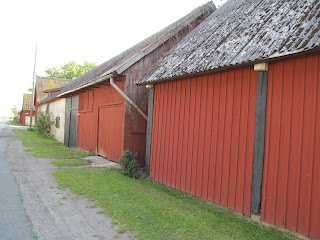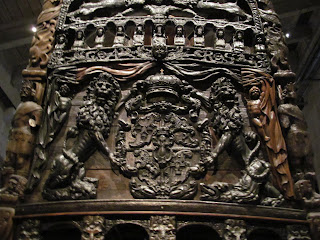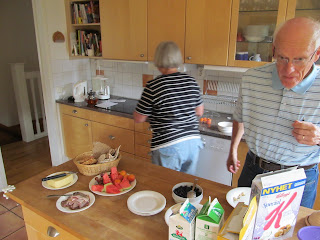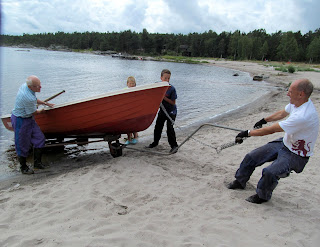WEDNESDAY, AUGUST 8, 2012--Åre
Gunnar, Mari-Anne, and I were up early and out the door at 0625 to meet a neighbor who drove us to the train station. We caught the train to Stockholm Central Station, then transferred to a train that took us to Åre (pronounced Orrra) in northwest Sweden. The total trip time was about 7.5 hours and it was a great way to travel to the north country. Initially, we followed much the same route to Gävle that we had driven southbound from our trip to Dalarnas during my first week in Sweden. From Gävle it was all new country to me. The farther north we went, the more it changed from the urban, rolling farmlands of the south. More houses were painted the traditional red color that the barns and other outbuildings have all over Sweden.
 |
| Swedish Farm |
A few homes were painted yellow, which seems to be a “favorite other color” for homes in Sweden. The farms were quite small by U.S. standards and were mixed with timber and some logging as we went north. From Bolnäs, midway through our 300-mile trip north followed by another 50 miles in a westerly direction, we followed water in the form of lakes and rivers nearly the whole way. In addition--the country became more and more rugged. We couldn’t tell it on the train, but we were climbing as we went north. It really was a beautiful trip through this part of the country! Logging seemed to become “king” as we went north because we saw more and more evidence of it. Sawmills, paper mills and piles of logs being loaded and unloaded were a common sight. I also noticed quite a bit of “clear cutting” being done in the north country, so I guess that method of harvesting timber has come to Sweden, too. Gunnar told me that logging has become quite mechanized resulting in a loss of jobs in the northland with people moving elsewhere to find work.
Oh, and I must mention our food on the trip. Mari-Anne had brought along coffee and tea as well as snacks for a mid-morning snack. Then, midway through the trip, Mari-Anne and Gunnar broke out the lunch--I am sure we had the best lunch on the whole train! Complete with a tablecloth, no less! It was delicious!
 |
| Lunch on the Train |
We turned west at Östersund to traverse the final 50 miles to Åre along a river and a long narrow lake in the bottom of a narrow, forested valley. Yes, it really made me feel like I was back in the mountains! We arrived in Åre at 1425, picked up the rental car and some groceries, and headed to the condo that the gentleman/neighbor who provided us the ride to the station this morning was letting us use for our stay. This is a beautiful location high up on the mountainside overlooking the valley with its lake running through it. After dropping our bags and groceries off at the condominium, we drove into town and took a short walk around to stretch our legs a bit.
 |
| Åre |
It is a charming town located in a major downhill skiing area, reminding me of some of the smaller ski resort towns in the Rocky Mountains. One source lists Åre as the largest ski resort area in Sweden and in 2009, Condé Nast Traveller named it winner of “World’s top ski resorts”. There are also quite a few long cross-country hiking trails up in this part of Sweden and I saw several backpackers in town.
We returned to the condo after checking out the town and surrounding area. Gunnar and Mari-Anne prepared a wonderful dinner of boiled potatoes and a skillet casserole dish with reindeer meat, vegetables, onion, and cream. They also served Lingonberry jam (a staple in Scandinavian cuisine)—just a little used with each bite of potato and the casserole. Ice cream and a chocolate mint from the local chocolate factory finished off the meal.
 |
| "Chef" Gunnar |
 |
| Ready for dinner in Åre |
After dinner, I helped Gunnar set up a geocaching account on his cell phone. A lively and interesting discussion of world politics (one of several such discussions we had) topped off the evening. This brought to end a long day filled with new sights and experiences.
FAST FACTS: The elevation at Åre is approximately 4700′MSL. Snow was in the mountains not very high above town and the tree line appeared to be about 5000′MSL. Temperatures were definitely cooler than in the Stockholm area that is at or near sea level. Åre is about halfway between 63°N and 64°N.
Very large parking lots for bicycles surround the train station in Uppsala. I would estimate there were easily several thousand bikes left there for the day by commuters. It seems nearly everyone rides a bike in Sweden; it is as normal as walking to your mailbox outside your house in the U.S. In addition, people of all ages use this mode of transportation. I didn’t see many motor scooters in either Norway or Sweden, but I did see quite a few motorcycles in Sweden (mostly Harley Davidsons).
 |
| Bicycle parking at Uppsala Train Station |
THURSDAY, AUGUST 9, 2012—Åre
We had a leisurely breakfast before heading out to explore the Åre area. Our first stop was Åreskutan Mountain (elevation 4656 ft. MSL) where we rode the tram most of the way up the mountain. We were above tree line shortly after we ascended from the tram station and we went into clouds just before reaching the upper station that is located just below the mountain’s summit. (Snowmobiles take skiers to the summit.) Patches of snow were around the higher areas and the temperature was -2°C with a blustery wind blowing when we got off the tram. This was quite a change from the 100°+ F temperatures I had left in South Dakota—and which they were still having! We took the next tram back down the mountain and the skies were beginning to clear while we descended. The weather was promising to be a beautiful day in the mountains.
 |
| Åreskutan Mountain |
 |
| Looking west from Åre |
We next drove to Tännforsen waterfall a few miles west of Åre. Tännforsen is one of Sweden’s largest unspoiled waterfalls, formed on a steep edge of a jutting section of slate bedrock. Special growing conditions exist here because of the near continuous existence of mist resulting in rare and interesting lichen on the slate rocks and trees around the falls. I saw numerous types of lichen that were the largest I have ever seen and I had no idea of all the various types of lichen that grow here. I am a lichen “watcher” when I hike because it is a good indicator of the air quality in an area; however, the varieties I saw in this area were really mindboggling! The park’s observation platform at the falls really takes you “up close and personal” to the roaring falls—and did they roar! There was no way that you could talk while on the platform because of the noise. This part of Sweden, as with Norway, had an abundance of moisture this year so the falls were really putting on a show for us.
 |
| Above Tännforsen waterfall |
 |
| Tännforsen waterfall |
Before leaving Tännforsen, we decided to have lunch. I had trout with a delicious dill sauce; we also had Swedish waffles with cloudberry jam for dessert. The waffles are thin by U.S. standards and are very light and fluffy. Cloudberries come from north of the Arctic Circle and the jam was very tasty. It is quite sweet with small seeds in it similar to seeds found in raspberries. All in all, this was a superb lunch!
Our final stop this day was at Njarka Sameläger (aka Njarka Sami Camp), a living open-air museum operated by a Sami woman and her husband. We arrived in time for the 3 o’clock tour but, instead of staying for the normal one hour, we didn’t leave until 1745! We were the only customers for the tour and since we seemed very interested in hearing what the woman had to say, she spent extra time explaining the Sami culture, political issues, lifestyle, etc., in addition to answering our myriad questions. After giving us a very complete tour of the camp, including new huts under construction, she invited us into one of the teepee-style dwellings at the camp and gave us coffee prepared over an open fire to drink while she prepared bread for us. The bread was cooked in a cast iron skillet and was good. We sat on the ground on reindeer hides and listened to stories she told us of Sami life and of the struggles they are having in today’s political system. She said she has encouraged her children to leave the Sami camp and get jobs elsewhere because their lives will be easier than if they live the traditional nomadic Sami lifestyle of raising reindeer. They have lost much of their traditional grazing land over the years to large hotels moving in and buying up vast quantities of land for guests that come to hunt. Other land has been bought up by different business and political entities with the end result being that reindeer herds have dwindled due to lack of grazing land availability. She said that some Navajo Indians from the U.S. had been in the day before and their stories were very similar to what the Sami have experienced. As we were talking, I was thinking of all the Native American villages and lands I have visited through the years, and the striking similarities between what the Sami are going through now and what the Native Americans have gone through. The woman was very passionate and, as I told Mari-Anne, she really had that “fire in her belly” when it came to sharing her story with us. All three of us came away with a much better understanding of the Sami culture and the problems they face today and beyond. We talked about her many times that day and in the days that followed. To say that she made an impression on us is an understatement!
 |
| Njarka Sami Camp |
 |
| Sami "backpack" |
 |
| Traditional Sami footware |
 |
Feeding reindeer
Coffee and conversation time in the Sami dwelling |
 |
| Our Hostess making bread for us |
 |
| Bread cooking over open fire (thanks for the pic, Mari-Anne) |
FAST FACTS: The Sami are indigenous to the Scandinavian Arctic with lands in Norway, Sweden, Finland, and the Kola Peninsula in Russia. The region where they live is usually called Sápmi, but sometimes Samiland. They have their own culture, language, traditions, and, since 1986, their own flag. There are approximately 20,000 Sami in 51 communities in Sweden.
Reindeer play a key part in Sami culture providing them with food and leather. The antlers are used to make knife handles and jewelry. Not all Sami are reindeer farmers as commonly believed; historically, they have made a living from fishing and other activities. Today, they are involved in tourism, clothes design, the media, and other professions similar to people outside their culture.
FRIDAY, AUGUST 10, 2012—Åre and back to Stockholm
We were up early and after breakfast, we cleaned the condo in preparation for our departure. With these chores done, we headed out on a 7 mile round trip walk to a nearby copper mine named Fröȧ Gruva (English: Fröȧ Mine) and associated buildings, including old homes, on the site. Mining began here in the 1740’s and continued during four periods until 1919. The site is now operated as an open-air museum and considerable restoration has been done to ensure visitors can see the unique pumping system operate at the mine. I am not an engineer so won’t try to explain the pump system but suffice it to say that the horizontal cross-arms connected to the vertical poles in the photo swing back and forth moving the long arms extending between the vertical poles in a back-and-forth action which, in turn, drives large wheels. It was a fascinating system to watch and I wish I could explain it better. Oh, and there is an “Earthcache” at this location so I was able to introduce Gunnar and Mari-Anne to this type of geocache while they bagged their first earthcache “find”. Soon it was time to hike back to the condo to gather up our belongings and head to the train station.

Fröȧ Gruva hike
 |
| Fröȧ Gruva Maypole |
 |
| Fröȧ Gruva home--don't remember date but built sometime in late 1700's/early 1800's |
 |
| Portion of Fröȧ Gruva pump system (still operates) |
 |
| Fröȧ Gruva waterwheel |
The train left right on schedule in mid-afternoon; however, we were delayed getting into Stockholm because of railway signal problems in the Stockholm area. We then caught the train from Stockholm to Jakobsberg where a son-in-law met us and drove us home, arriving there just before midnight. Mari-Anne prepared coffee/tea and snacks, as well as a nice dinner complete with a tablecloth, again, for our return trip. The food was very good and very much appreciated!
FAST FACTS: I saw a lot of grass roofs in Norway and Sweden. In Norway, new buildings (including holiday homes) constructed in areas with a lot of visitors, such as mountain resorts and/or ski areas, must conform to environmental standards; i.e. they must “blend in” to their surroundings. Grass roofs are one means to accomplish this. I don’t recall seeing many on newer buildings in cities and villages, most were on older buildings in those areas. However, there were a lot of grass roofs in rural areas. In Sweden, there is a move to have grass roofs on buildings (even in cities) because they are efficient and environmentally friendly. Gunnar mentioned several newer large buildings right in their town that have grass roofs. The roofs are an important element there in urban storm sewer planning since they significantly reduce the amount of water runoff, in addition to providing very good insulation from hot and cold temperatures, among other benefits. Generally, these roofs have a lifespan of 2-3 times greater than a conventional roof.
I did not see any maypoles in Norway; however, they are very prevalent in Sweden where new ones are erected with lots of fanfare in mid-June when the hours of daylight are longest.









































































